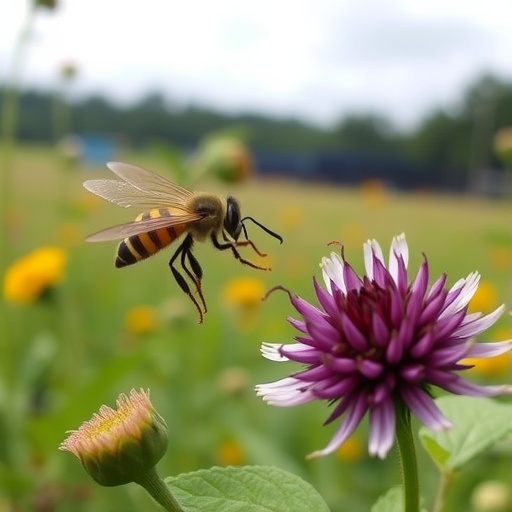Pollinators such as bees and butterflies are indispensable contributors to global food production, as they facilitate the reproduction of approximately 35% of the world’s food crops, including vital fruits, vegetables, nuts, and seeds. Despite their critical ecological function, pollinators face alarming declines worldwide, driven largely by habitat loss, especially the diminution of wild land areas amid agricultural expanses. Recent research spearheaded by an international team of scientists, including University of Washington biology professor Berry Brosi, has delved into the critical thresholds of natural habitat needed within agricultural landscapes to sustain healthy populations of diverse insect pollinators.
The study, published in Science on September 25, 2025, involved an unprecedented synthesis of over 178,000 individual insect pollinator records from 19 countries, encompassing groups such as bumble bees, solitary bees, hoverflies, and butterflies. It delivered robust, data-driven insights into minimum habitat requirements, revealing striking interspecies variation. For instance, hoverflies require as little as 6% natural habitat within agricultural zones, whereas butterflies necessitate substantially more, with at least 37% natural habitat to maintain viable populations. This gradient underscores the complexity and biodiversity-dependent nature of pollinator habitat conservation.
A core conceptual advance of the study lies in the dual consideration of habitat quantity and quality. Beyond simply preserving natural areas, the nature and temporal availability of floral resources within these habitats profoundly influence pollinator survival and ecosystem services. Agricultural monocultures typically offer brief flowering periods, insufficient for sustaining pollinators throughout their life cycles. As Berry Brosi elucidates, fertile semi-natural elements such as diverse field margins, hedgerows, and small forest patches must supply continuous floral resources across seasons to support pollinator nutrition and reproduction effectively.
The researchers conducted a comprehensive meta-analysis of 59 datasets, including longitudinal data from Costa Rica contributed by Brosi’s doctoral and postdoctoral research. They found that the minimal habitat percentages necessary for pollinator persistence generally exceed the quantitative targets currently adopted or proposed by governmental bodies. For example, the European Union’s target of 10% natural habitat on agricultural lands by 2030 appears insufficient for many pollinator taxa. These findings call for policymakers to revise conservation benchmarks upward to curtail pollinator declines and safeguard crop pollination services.
In the United States, although specific habitat mandates for pollinators are lacking, the study’s conclusions have immediate implications. The U.S. Department of Agriculture’s Conservation Reserve Program (CRP), which incentivizes farmers to retire marginal cropland from production, now includes provisions encouraging the establishment of pollinator habitats. Brosi highlights that while the program effectively aligns farmer economic interests with ecological stewardship, existing demand exceeds supply in some areas, such as Chelan County, Washington. Enhanced funding and expansion of CRP-like initiatives could create a win-win situation benefiting both farmers and declining pollinators.
Within Washington state, current legislative efforts resonate with the study’s recommendations. For example, state laws reducing pesticide risks to pollinators and requiring that 25% of public works landscaping be converted into pollinator habitats are aligned with or exceed the minimum habitat proportions identified as essential by the research. Though these measures represent initial steps, scaling such policies and cross-sector collaboration will be crucial to address the wider landscape-level needs of pollinator conservation.
Washington’s native pollinator fauna include species of significant agricultural and ecological relevance. The alkali bee (Nomia melanderi), native to dry regions including central and eastern Washington, is a prime example. This bee is essential for alfalfa seed production, a crop with unique floral structures poorly serviced by introduced honey bees. Alkali bees require specialized nesting habitat characterized by high soil salinity and carefully managed moisture regimes. Some farms maintain dedicated salt-rich mud patches—practiced management over decades has supported millions of nesting females, showcasing a symbiotic agricultural practice that sustains pollination security through native species conservation.
Bumble bees also illustrate the critical link between habitat and crop productivity in Washington. Thirteen species of bumble bees native to the state contribute significantly to agricultural pollination, particularly in early-season crops when temperatures remain low. Their ability to thermoregulate and engage in buzz pollination—using wing vibrations to extract pollen from flowers like tomatoes—underscores their unique ecological niche. However, bumble bees’ survival depends on diverse floral resources distributed throughout growing seasons, emphasizing the necessity for a mosaic of natural habitats within agricultural matrices.
The research fundamentally challenges simplistic models that equate habitat preservation only with land area, underscoring instead the nuanced interplay of habitat composition, floral diversity, and seasonality. Maintaining a heterogeneous landscape that supports pollinator nutrition, reproductive cycles, and nesting sites is essential to sustaining these keystone species and the vital ecosystem services they provide. The study’s quantitative thresholds offer a scientifically grounded framework for updating conservation targets nationally and internationally, with profound implications for food security, biodiversity preservation, and sustainable agriculture.
Funding sources for this groundbreaking project ranged across several esteemed foundations and educational programs, including the Anne M. and Robert T. Bass Stanford Graduate Fellowship, the Koret Foundation, and the Moore Family Foundation, reflecting the interdisciplinary and collaborative nature of the work. The detailed analysis and policy-relevant conclusions derived from this extensive data synthesis provide a clarion call for governments, farmers, and conservationists to elevate habitat conservation practices and secure the future of insect pollinators amid expanding agricultural demands.
For further inquiries and detailed scientific discussions regarding habitat requirements for pollinators and possible strategies to embed these findings within agricultural and land-use policies, please contact Berry Brosi at bbrosi@uw.edu.
Subject of Research: Pollinator habitat requirements in agricultural landscapes and their implications for conservation and agricultural productivity.
Article Title: Critical habitat thresholds for effective pollinator conservation in agricultural landscapes
News Publication Date: 25-Sep-2025
Web References:
- DOI link to article
- USDA Importance of Pollinators
- USFWS Pollinator Threats
- European Environment Agency Target
- USDA Conservation Reserve Program
- Alkali Bee Information
References:
Brosi et al., “Critical habitat thresholds for effective pollinator conservation in agricultural landscapes,” Science, September 25, 2025, DOI: 10.1126/science.adr2146.
Image Credits: Karen Levy
Keywords: pollinators, habitat conservation, agricultural landscapes, bees, butterflies, hoverflies, bumble bees, alkali bee, pollination, biodiversity, ecological thresholds, sustainable agriculture




